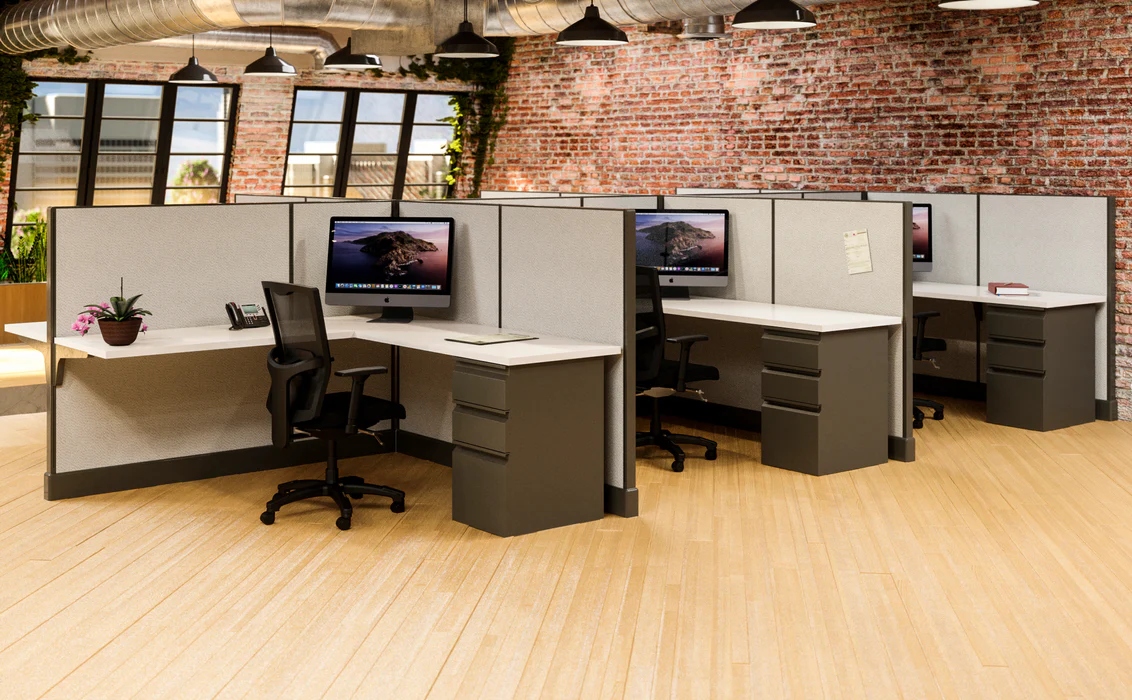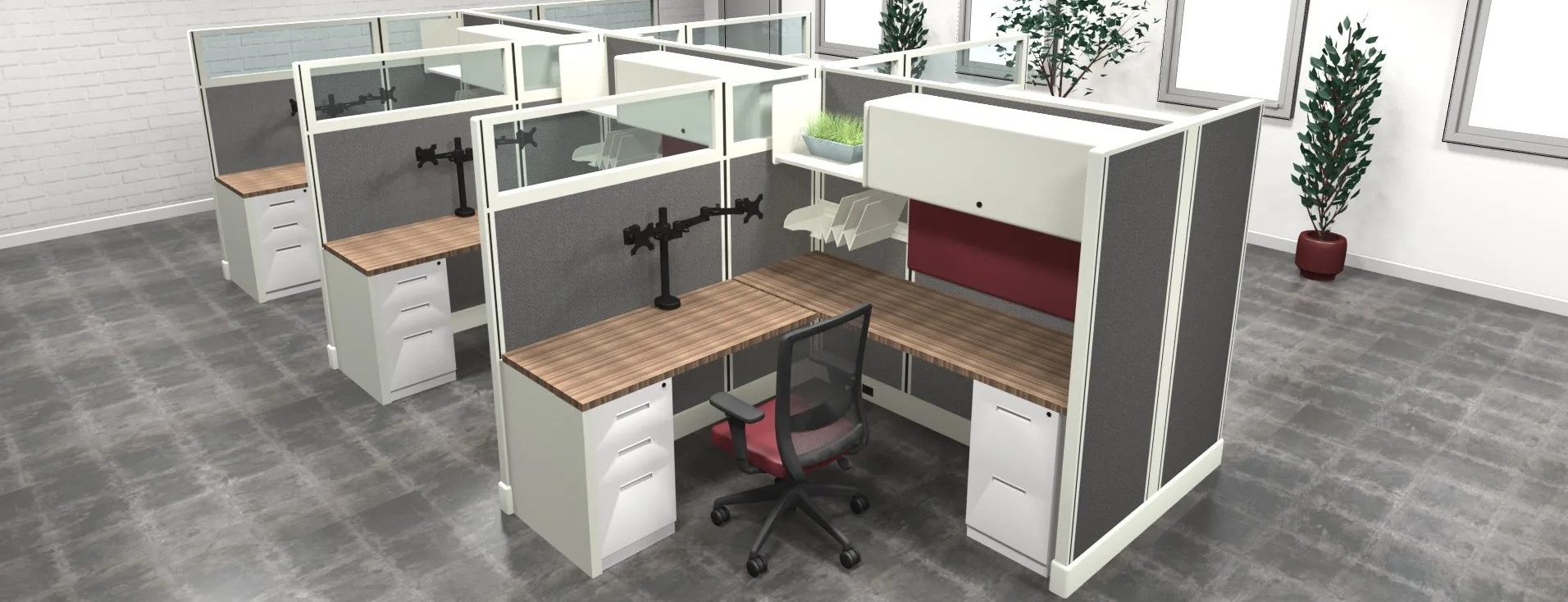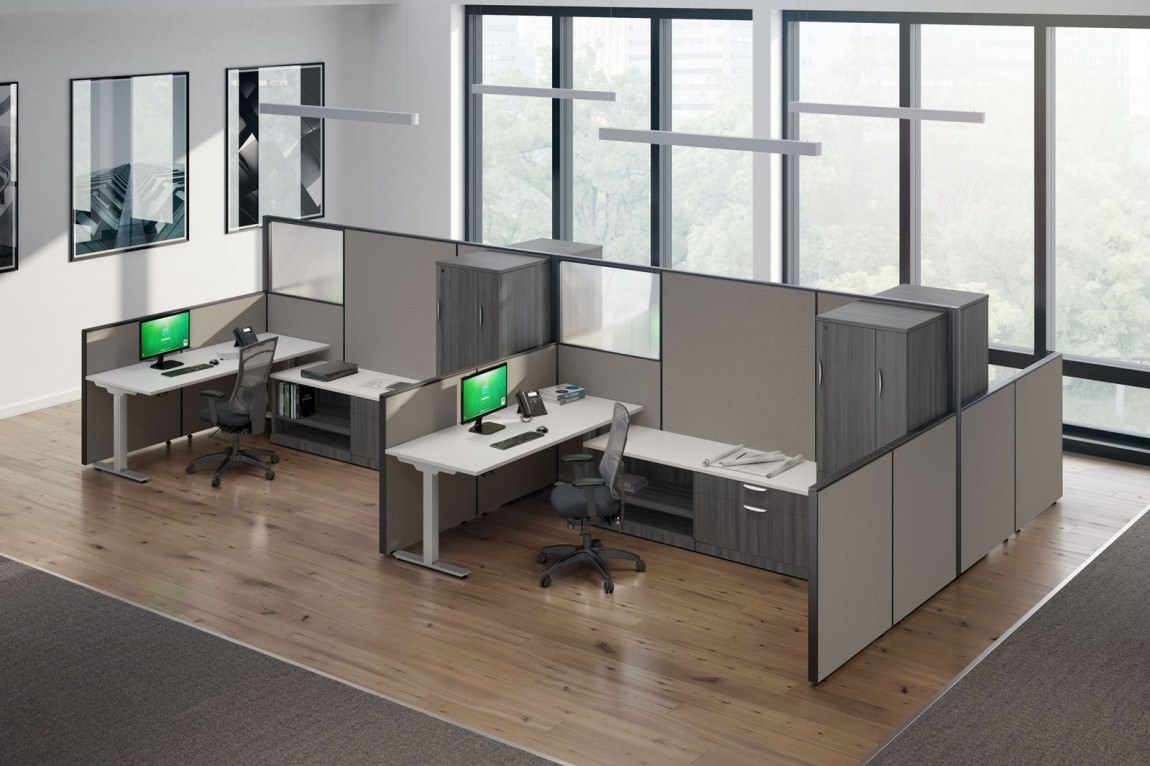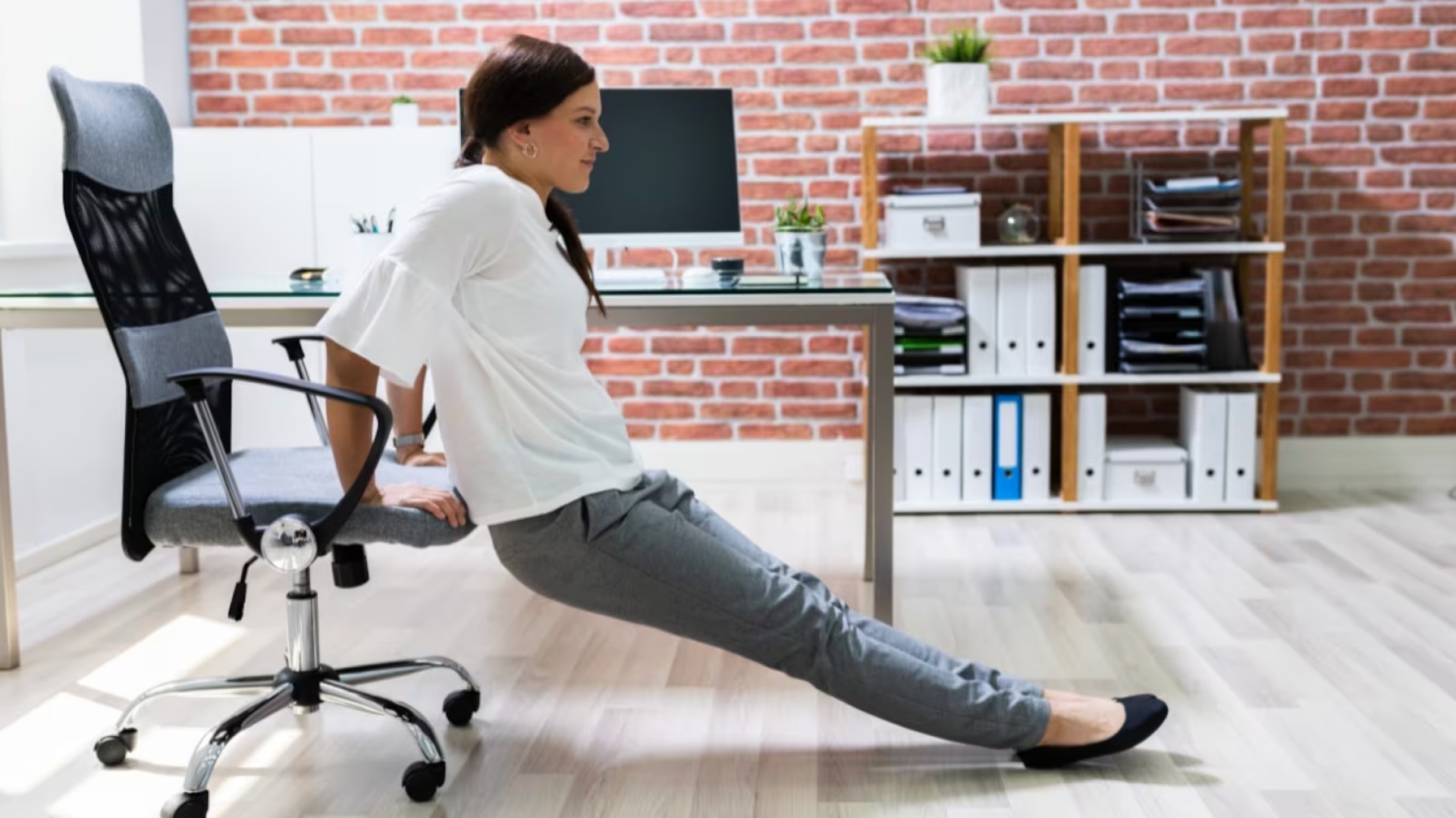Comments
- No comments found

In the office design, reusing office cubicles can be eco-friendly and cost-effective. But what creative transformations are possible with these staple features of office life?
We'll explore the various types of cubicle structures and how they can be adapted to fit new purposes. From collaborative workspaces to unique storage solutions, the potential for reinvention is vast.
Are you ready to rethink the way you view these used office cubicles? Join us as we delve into the art of cubicle repurposing and breathe new life into your workplace design.

Breakout areas are transforming the face of modern office landscapes. Imagine a used cubicle-once a solo workspace, now reimagined into an interactive hub.
By taking apart used desk partitions, we set the stage for collaborative spaces. Easy to access, these areas foster teamwork and spur innovation.
They dismantle the 'silo' mentality and open up new channels for communication. When crafting these zones, consider:
Moveable panels from used desks allow for adaptable layouts. Create a space that can be easily reconfigured. It is to accommodate different group sizes and activities.
Add comfortable seating, such as plush armchairs or bean bags. It is a relaxed atmosphere conducive to creative thinking.
Integrate technology into the design with charging stations, whiteboards, and video conferencing equipment. It will enable teams to brainstorm and communicate seamlessly.
Strategic positioning of used desk panels can still provide seclusion for focused group tasks. It ensures the flexibility to go from a collaborative space to an individual workspace.
Private pods revolutionize the concept of personal work areas. Cubicle walls find new purpose in these mini-offices. They offer solitude within the bustling office environment.
Each pod becomes a sanctuary for focused tasks. It's an escape for employees seeking silence or confidentiality. Private pods empower workers with control over their workspace.
They choose when to engage with the greater office and when to retreat. Pods can house computers, desks, and necessary tools. With sound-absorbing materials, they minimize noise.
They are ideal for phone calls, virtual meetings, or deep work. The design is compact and efficient, maximizing office floor space.
Private pods reflect a commitment to employee well-being and productivity. They acknowledge the need for a balance between collaboration and privacy in modern work cultures.
Green walls, also known as living walls, inject a burst of nature into office settings. Old cubicle panels serve as the backbone of these vertical gardens. Installing a grid on the cubicle structure allows the addition of foliage.
Plants enhance air quality and bring a refreshing element to the workspace. Employees often experience a boost in mood and productivity around greenery. Maintenance is simple with a built-in watering system.
Each green wall is unique and tailored to the office aesthetic. It can be a focal point or a subtle backdrop. Either way, it transforms the feel of the office.
Green walls are a testament to a company's commitment to sustainability and employee wellness. They break the monotony of traditional office designs and foster a greener, more vibrant environment.
Repurposing design cubicles into art stations injects a wave of creativity into the office atmosphere. Design cubicles, which were once considered a symbol of compartmentalized work, have now transformed into a medium for artistic expression. They provide employees with a space to unwind and engage in artistic pursuits.
Each art station can host supplies for drawing, painting, or crafting, allowing for a mental break from the digital world. These stations encourage spontaneous collaboration and idea-sharing, nurturing a vibrant community of innovators.
By integrating design cubicles into these areas, offices make use of existing resources and promote an environment where creativity is a valued part of the workday. The presence of art stations speaks to the company's dedication to fostering a holistic and dynamic work culture.

Community boards emerge as dynamic centers for office communication. Use old cubicle walls to create these boards. They become hubs where team updates, company news, and employee accolades shine.
The positioning is key-place them in common areas for high visibility. Staff can pin announcements or share inspiration and insights. Swift idea exchange happens here; a glance sparks conversations.
Quick updates or event posters find a home on these boards. They encapsulate a company's pulse-vibrant, informative, and interactive. Use color codes or sections for clarity.
These boards, recycled from cubicle panels, mirror a company's resourcefulness and heartbeat. They bridge departmental gaps, enhance transparency, and cultivate a connected community within the workspace.
Relaxation nooks transform quiet corners into serene retreats. Imagine an unused cubicle corner. Now, picture it as a tranquil getaway.
Soft lighting sets a restful mood. Comfortable seating invites repose. These spaces offer staff a moment of solitude.
Cubicle partitions provide an intimate setting, perfect for de-stressing. It's a pause from the hum of office life. A potted plant or two adds freshness to the air.
Employees recharge here amidst gentle colors and textures. Every nook and cranny is a nod to mindfulness. They respect the human need to slow down.
The idea is straightforward, yet the effect is profound. It serves as a tranquil haven to rejuvenate the mind and spirit.
Repurposed cubicles rise to a new life as library units within the agile office. Each shelf emerges from frames of used furniture, skillfully reassembled into bookcases.
These structures store knowledge and resources that are critical for workplace learning. But it's not just about storage. These library units symbolize sustainability and ingenuity.
They provide a second chance for used furniture. Old cubicles convert into places of learning and discovery. Employees find literary gems nestled between guides and manuals.
The design is sleek yet functional. All while upholding the values of reuse and repurposing. Imagine the character these units bring.
Used furniture now holds the weight of words. Each book is a seed for growth. Aged cubicles now support the future of workplace education.
Used cubicles offer an excellent foundation for innovative storage solutions. Their sturdy frames are perfect for shelving. Imagine converting old cubicle walls into storage space.
Files stay tidy, and supplies are hidden yet accessible. These used cubicles beat clutter with style. They morph into lockers, cabinets, or drawers.
Each design is tailored to organizational needs. Creativity turns these old cubicles into decor. They blend into the office, sleek yet functional.
Team members store personal items securely. Used cubicles now keep workspaces neat. Their new life combats office chaos.
And these unique solutions respect our planet. Reduce, reuse, and reorganize-principles these cubicles now embody.
Display shelves crafted from old cubicles celebrate success. These shelves become showplaces for recognition and awards. They highlight company milestones.
Employee achievements adorn these walls. They showcase trophies and certificates with pride. Cubicle frames are reborn with a fresh purpose that ignites inspiration.
Elevate the look with elegant shelves crafted from wood, metal, or glass. They reflect a corporate culture that honors excellence. These shelves are more than storage.
They are symbols and tokens of a journey of hard work and motivation. Colleagues look up to them as role models, uniting the team towards common goals. Cubicle partitions evolve into a narrative canvas depicting triumph and persistence.
Modular meeting rooms transform collaborative spaces by embracing flexibility. Old cubicles transform into dynamic meeting areas. Each room adapts to team sizes and purposes.
Walls are rearranged for privacy or openness. These rooms foster creativity and exchange. They accommodate everything from formal presentations to casual brainstorms.
Modular pieces allow for quick reconfiguration. They encourage spur-of-the-moment huddles. Teams craft spaces for their unique needs.
Furniture on casters shifts to suit various layouts. Technology integrates seamlessly, providing connectivity. Idea sharing happens in real-time.
The spaces are efficient; they maximize office real estate. Modular rooms symbolize ingenuity in modern office design. They prove that with vision, the ordinary becomes revolutionary.
Revamped cubicles now define workshop areas. They segment space for projects and brainstorming. Easily movable, these dividers adapt to the tasks at hand.
Workshops can expand or contract swiftly. Panels provide physical and acoustic separation. Each section fosters focus and minimizes distractions.
Teams circle, and ideas flow freely. Materials and tools stay well organized within reach. These dividers are more than barriers.
They support a transforming workflow. Privacy is available when needed. Openness, too, takes just a few moments to achieve.
Dynamic, agile, and responsive, these dividers excel. They are the skeleton of modern, versatile workshops. Reimagining cubicles brings forth this new potential.
Office spaces now buzz with renewed energy. Workshop dividers are a smart solution for repurposing old cubicles.
Reception desks are the gateway to your office. They embody the company's ethos. First impressions are crucial.
Visitors can gauge your brand identity here. Recycled cubicles form the foundation. These desks are stylish yet sustainable.
They stand as a greeting point. Function meets sophistication in their design. Employees welcome guests with ease.
Ample space allows for efficient service. The design is customizable to brand colors. Sleek lines and clean surfaces prevail.
The logo placement is prominent yet tasteful. Reception areas become memorable through these desks. They dictate the tone for office visits.
A reclaimed cubicle desk starts the journey. It symbolizes eco-consciousness and innovation. Reception desks are inspired this way.
They show thoughtfulness in every detail. A commitment to sustainability is clear.
Training modules crafted from old cubicles are innovative. These spaces inspire learning. Workers engage with new skills nearby.
Each module is a hub for education, positioned strategically within the office. Learning becomes integral to the daily flow.
Cubicle walls offer privacy and focus. Yet, they remain accessible to all staff. Visuals and tools attach easily to the panels.
Modules are both functional and discreet. Individual or group training is possible here. Tech integration is seamless.
Learning grows from these repurposed structures. The design is smart and minimal. Knowledge transfer is at its heart.
Training modules like these emphasize continual development. Former cubicles now foster future expertise. They make learning central to the office landscape.
Transforming old cubicles into café counters redefines break spaces. These counters create casual spots
for colleagues to connect. Reused panels are reimagined into bar-style seating.
Each counter offers a fresh area for coffee and conversation. Interactions brew naturally here, fostering community. The setup is simple, with stools and fixtures.
Light snacks and beverages find their place. Employees gather for brief, well-deserved pauses. Energy renews with each sip and bite. These counters reflect a modern, eco-friendly vision.
Old cubicles gain a vibrant new purpose. Office culture flourishes around these casual, inviting counters. Reclaimed cubicle panels now frame social hubs.
They unite staff and make connections happen. Café counters are the future of break areas. It is an easy update for a lively, rejuvenated office.

Fitness zones rise from old cubicle remains. They are beacons of wellness within the office. Treadmills replace filing cabinets.
Yoga mats unfurl where desks once stood. Free weights sit where paperwork is piled. These areas echo with encouragement.
Workouts weave into workdays effortlessly. Employees energize with each rep and each stretch. Busy minds find solace in physical activity.
Health becomes a community endeavor. Colleagues motivate, side by side. Each zone commits to staff well-being.
Old structures support new goals. Strength grows, both corporate and physical. Fitness zones convert cubicles into cornerstones of vitality and speak to the company's values.
Reimagined workspaces now bolster endurance, both mental and physical. And it all started with old cubicles. The heart of a healthy office is here.
Workplaces are repurposing used office cubicles into vibrant, functional areas. From art stations to fitness zones, each transformation signals a shift towards a more dynamic and sustainable office culture. These once-static partitions now embody innovation and collaboration, making the office a versatile landscape for productivity and creativity.
Sustainability drives these changes, revealing a commitment to the planet and the evolving needs of a modern workforce. Used cubicles are no longer relics of a bygone era but pillars of a forward-thinking office design.
Did you find this article helpful? If so, check out the rest of our site for more informative content.
Leave your comments
Post comment as a guest